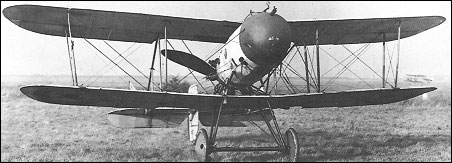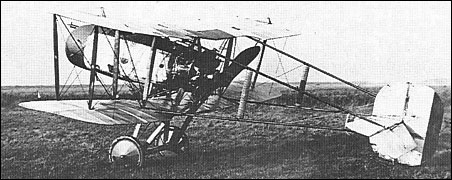|
| A compact two-bay biplane of pusher type, the F.B.12 was designed for the 150hp Hart static radial engine, in the development of which the Hart Engine Company was being assisted by Vickers. With a single-seat nacelle faired out to a circular cross section and mounted in mid wing-gap, and tailbooms converging in side elevation to meet at the rear spar of the tailplane, the F.B.12 had a basic structure primarily of steel tube. Unavailability of an airworthy Hart engine led to the first F.B.12 being fitted with an 80hp Le Rhone rotary, with which it flew in June 1916. Although underpowered, it demonstrated a creditable performance when tested at the Central Flying School in the following August. The Le Rhone was then replaced by a 100hp Gnome Monosoupape, and, subsequently, new wings of greater span were fitted - overall span being extended by 1.09m - with straight raked rather than elliptical tips. Redesignated F.B.12A, this aircraft was sent to France for operational evaluation in December 1916. A further aircraft was built - by Wells Aviation of Chelsea - with the Hart engine as the F.B.12B. This was flown early in 1917, but promptly crashed, helping to seal the fate of the Hart radial. A contract for 50 aircraft powered by the Hart had, on 10 November 1916, been awarded Vickers, the intention being to fit the series aircraft with a new, wooden nacelle and enlarged vertical tail surfaces as the F.B.12C. Production of the F.B.12C was sub-contracted to Wells Aviation, but with the loss of the F.B.12B, the Hart engine was abandoned. In the event, only 18 F.B.12C airframes were completed and these were fitted with a variety of engines, including the 110hp Le Rhone nine-cylinder rotary and the 100hp Anzani 10-cylinder radial. Testing at Martlesham Heath in May 1917 revealed insufficient elevator control at low speeds, heavy lateral control and other problems. Furthermore, the gun (a 7.7mm Lewis) was considered to be badly positioned for changing ammunition drums. By this time, tractor fighters of superior performance were in RFC service and further development of the F.B.12 was therefore discontinued.
| MODEL | F.B.12C |
| WEIGHTS |
| Take-off weight | 656 kg | 1446 lb |
| Empty weight | 420 kg | 926 lb |
| DIMENSIONS |
| Wingspan | 9.02 m | 30 ft 7 in |
| Length | 6.65 m | 22 ft 10 in |
| Height | 2.62 m | 9 ft 7 in |
| Wing area | 22.02 m2 | 237.02 sq ft |
| PERFORMANCE |
| Max. speed | 140 km/h | 87 mph |
| Ceiling | 4420 m | 14500 ft |
 | A three-view drawing (606 x 276) |
| dashanya, 20.06.2011 13:59 you give me any information on this?!!!! Looking forward to hearing from you. reply | | Sandy Beach (Mrs), e-mail, 05.10.2010 20:48 Iam the manageress of an Age Concern Charity Shop in Kent and have today been donated a clock made out of a propeller of what I assume to be a vickers fb12. This clock has the following markings burnt into the top and bottom of the propeller part. Top 100 H . P. V. G. 633 Series 12 DRG 2187V
Bottom B2 MONO GNOME P 67 0
Unfortunately the base has been added and obscures the rest of the writing on the bottom. I has been very well carved and sculpted and has a clock in the centre which I feel might have been part of the planes instrumentation which bears the following Smiths Cricklewood Works London N.W P. 281.948 Can you give me any information on this?!!!! Looking forward to hearing from you. reply |
|
Do you have any comments?
|
| 
COMPANY
PROFILE
All the World's Rotorcraft
|








